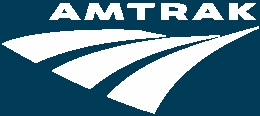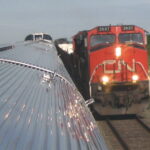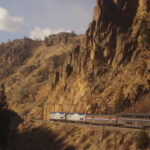Historic Transportation Bill Emerges.
Well, you just never know, do you! Just think: a year ago, a funding bill in the U.S. House had an amendment tacked onto it that would have ended all federal subsidies for Amtrak. Make no mistake, it probably would have meant the end of Amtrak . . . without question the long-distance trains wouldn’t have survived, and maybe not even the Northeast Corridor.
Today, after weeks of negotiations, conferees from the House and the Senate released a final transportation bill, the Fixing America’s Surface Transportation (FAST) Act. It’s a “break through” piece of legislation in several significant ways.
First—and isn’t this remarkable all by itself!—it’s the first time ever that passenger rail has specifically been included in a comprehensive transportation bill. I must add here that NARP, as an organization and through thousands of individual members, has been working for this one significant objective for a long time.
Second, this bill sets specific dollar amounts of support for Amtrak for five years—from 2016 through and including the year 2020. And that’s a big deal because for most of it’s 40-plus year history, Amtrak has had to go hat-in-hand to Congress for annual appropriations … meaning they’ve had to make budgetary decisions a year at a time and without knowing how much money they’d have. My God … you couldn’t run a cigar stand that way!
And, third, while it’s still not enough, this bill sets out specific dollar amounts that increase year by year. After limping along for years with annual subsidies of around $1.4 billion, the Amtrak planners now know that they will get almost $1.7 billion from the feds next year and that amount will increase every year to nearly $2.5 billion in 2020. The five year total, in round numbers, is $10.36 billion.
There are still many questions to be asked and more specifics to come, but for a lot more detail, you can follow this link to the NARP web site.
There is also still more work to be done, because this bill has to pass both the House and the Senate before it becomes law and is a done deal. Individual members of the House and the Senate will have to be convinced to vote for the FAST Act. Again, to help in that effort, consult the NARP web site where there will soon be a great deal of information to assist everyone in that effort.
But, for now, the good guys have scored a big one!





Not having a consistent source of multi-year funding has crippled Amtrak from planning and purchasing in a cost efficient manner, as any viable business requires. However, Amtrak remains a state-operated enterprise, with just more oversight in its state services.
At this point, with the passage of FAST by Senate/House, we need to reflect on certain realities:
1) To take Amtrak forward into 2020, are we not at the junction where Mr. Fox at DOT recognizes we require a new leadership team for Amtrak, in the spirit of David Gunn or Graham Claytor? (remember how Eisenhower did not hesitate to replace Fredendall with Patton to change the momentum in Tunisia in ’43?)
2) “When pigs fly” will Amtrak’s current leaders return the diner amenities, re-build or order cars, or upgrade cars. In fact, not even today does Amtrak recognize its own NEC market, by ignoring the need for 2 additional classes on its all purpose “NE Regional.” To compete with Megabus/Bolt/Peter Pan curbside bus firms, a new T Class (Tourist) is required for a bare-bones coach to serve the elderly and college students now attracted to these “Chinatown-type” bus schedules/fares. In respect to the fact that the “NE Regional” is not so much an end point to end point run, but rather, serving many intermediate markets, this service also requires a First Class car, as it used to offer when running “named trains.”
3) The opportunity is upon us to either hunker down to study and learn from VIA Rail Canada and adopt its ways, or, accept bids from other operators, such as Virgin, to replace the Soviet-style catering, stripped out non-NEC first class and diminishing sleeper amenities; re-introduce true bar/club cars with cocktails, and dump the pathetic, unhealthy, uninviting Amcafe mode; to aggressively price and market expanded state corridor services; to institute a training program for OBS staff to ensure an improved dining and lounge experience for passengers. Most importantly, to cease outsourcing HR and return it as part of the company’s management team; to inculcate HR with knowledge, culture, and spirit of railroading; to ensure improved recruitment, training, and retention of appropriate people.
We must remember how the Class 1 freight railroads evolved–after the 1906 Hepburn Act that inserted price controls and eliminated competitive pricing, etc, with a few exceptions (Perlman, Heinemann, Marsh, Reed), railroading could not recruit the best management talent, as little was required of leadership. However, once Staggers Act came about in 1980, and the railroads were deregulated and free to compete, look at their CEO roster since then! Exactly what should now occur re Amtrak–with the start of 4 years of contiguous funding, we now require a savvy railroad business person who understands marketing, cost : price, service, government relations, a persona of leadership and determination, and how to build and expand revenue, in the mold of a David Gunn, previously one of two of Amtrak’s best CEOS (the other being Graham Claytor).
Without these requisite changes, Amtrak will be far from the theme “if they build it, they will come..?”
If this passes, then perhaps Amtrak can now go in a much better direction. Examples would be to replace old worn out cars, enhance the food service by bringing the diner back up to par, change the “cafe” into a real cafe where a small kitchen could be installed and serve fresh food (vending machines could continue to sell the other stuff that the current “cafes” sell), introduce new on-board services like enhanced coach seating (possibly lay flat seats for long distance routes), and even introduce something like an economy sleeper class of service which would help enhance the traditional sleeper class by reinstating all or most of the amenities that were taken away previously. This would result in 4 classes of service: standard coach, enhanced coach, economy sleeper, and traditional sleeper. These little improvements in itself would help produce more ridership. With the extra funding, maybe a national advertising campaign could be mounted along with the new service enhancements. Again all to achieve more ridership. Nevertheless, as long as this is passed, this is definitely the right starting point.
Food service and other ‘demanded’ cuts would most likely be uneffected by this bill. There is a lot of noise in this bill about increasing Amtrak’s “accountability” [which rarely means anything productive]. It also makes Amtrak more “accountable” to the states.
The funding increase looks good on paper; the devil may be in the details. I certainly hope this one can go in the Win column.
The big negative is that Congress continues to tell Amtrak how they should be running the railroad.